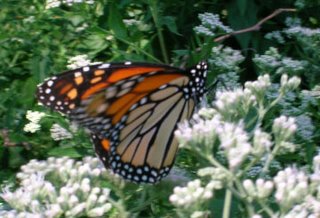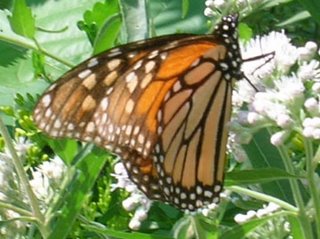Migration Time

The leading edge of the 2006 monarch migration has begun passing through Chicago. It's been a good summer for monarchs so far here in the Chicago area, so I'm hoping for a strong migration this year. There have been three distinct local generations of monarchs this year: one in late June, one in early August, and one that is just now emerging from the chrysalises. Typically, there are small numbers in the earliest generation, with more abundant second and third generations. This year, the number of first generation monarchs was typical of what one would see later in the summer. The second generation was as abundant as we typically see during the migration. It’s too early to tell what will be seen with the current generation, though if the pattern holds, it could be very large.

Adults from generations I and II live for about two weeks, which is typical of adult butterflies in this part of the country. The current generation is very different from the previous two, however. The shorter day length at this time of the year stimulates the butterflies to produce a substance called juvenile hormone. This compound sends the butterflies into reproductive diapause. In other words, they stop breeding. It also increases their lifespans, and they will live eight to nine months. Their circadian clocks stimulate the onset of migratory behavior.

By the middle of next week, the peak of the migration should be passing through Chicago. The butterflies will continue to fly southward, stopping along the way to take nectar from flowers and to roost for the night. By early November, they will be near Morelia, about 100 miles WNW of Mexico City, where they will spend the entire winter. The most remarkable part of the journey is that the butterflies find the same tiny refuges year after year, yet they are at least four generations removed from the last butterflies to make the trip. We are learning more and more about how the butterflies navigate. Still, our level of understanding is analogous to knowing how a compass works, when the question at hand is how a pilot navigates to a distant airport.
These monarchs were photographed in Lincoln Park in Chicago. They are on late boneset, a plant that is used heavily by migrating monarchs in northern Illinois.
Labels: Butterflies, Monarch, Phenology


9 Comments:
Are the butterflies that fly to Mexico the same ones that come back in the Spring or is there a breeding (or two) that occurs in Mexico?
There is no breeding in Mexico. The butterflies hand out in Mexico for the entire winter. They come out of reproductive diapause in March and begin mating just before they leave Mexico, but they don't lay eggs until they get to Texas. Most of them then die, and it's the progeny that get back up here.
From time to time through the fall and winter, I'll post more about what they are doing.
Those pics are beautiful, Doug!
The neighbors on either side of us have purple butterfly bushes and earlier this summer they were covered with butterflies (mostly monarchs I think) during the day.
nature never ceases to wonder me; how this evolved and happened that animals who 'never been there' know where to go.
We have a similar experience here with the Rufous Hummingbirds. The juveniles are the last to leave and somehow find their way to Mexico and then take a different route back in the spring. The major difference is they don't breed and die on the way back.
I've always wondered how the monarchs did this and the longer life span explains part of the mystery. I guess genetic imprinting is far more complex than we may ever understand in our lifetimes.
I really enjoy you sharing some of these mysteries with us laymen.
When we were kids we would collect the monarch chrysalises on milkweed stems and put them in a canning jar with a lid with punched holes it it. We would watch the chryalises slowly turn darker and it was exciting to watch the butterflies come out. Then we would take them outside and watch them fly away.
Homer, I did the same thing and always really enjoyed it. Did you ever get to actually see the butterfly emerge? The chrysalis sits for hours unchanged, then the whole process is over in about a minute, so it's really easy to miss. I've now gotten to watch thousands of butterflies emerge from their chrysalises, and it never gets old.
Doug...
What incredible photographs! Did you take these personally? MOnarch Butterflies...butterflies in general. Boy did my childhood years come rushing back. It wasa almost a yearly thing for us to be fishing out caterpillars, confining them to jars, and watching it all happen.
Hi Tony,
Yes, the photos are mine. I went out onto the museum grounds and took some pictures before posting the entry. I think that they are OK only. I have a couple of friends whose abilities in photographing butterflies always leave me amazed. My friend Marla has some pix that, when you increase the magnification, you can actually pick out individual scales on the butterfly wings. These don't come close to that resoultion.
I've been amazed at the number of people who have written to say that they have raised monarchs when they were kids. Does my heart good to hear this.
Post a Comment
<< Home